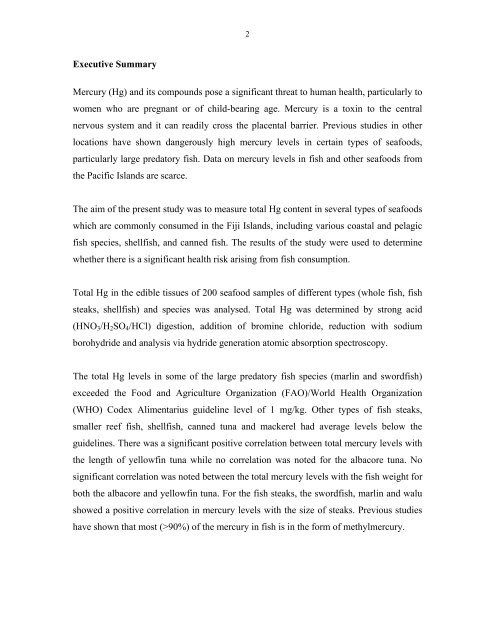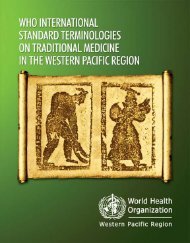Mercury Levels in Fijian Seafoods and Potential Health Implications
Mercury Levels in Fijian Seafoods and Potential Health Implications
Mercury Levels in Fijian Seafoods and Potential Health Implications
Create successful ePaper yourself
Turn your PDF publications into a flip-book with our unique Google optimized e-Paper software.
Executive Summary<br />
2<br />
<strong>Mercury</strong> (Hg) <strong>and</strong> its compounds pose a significant threat to human health, particularly to<br />
women who are pregnant or of child-bear<strong>in</strong>g age. <strong>Mercury</strong> is a tox<strong>in</strong> to the central<br />
nervous system <strong>and</strong> it can readily cross the placental barrier. Previous studies <strong>in</strong> other<br />
locations have shown dangerously high mercury levels <strong>in</strong> certa<strong>in</strong> types of seafoods,<br />
particularly large predatory fish. Data on mercury levels <strong>in</strong> fish <strong>and</strong> other seafoods from<br />
the Pacific Isl<strong>and</strong>s are scarce.<br />
The aim of the present study was to measure total Hg content <strong>in</strong> several types of seafoods<br />
which are commonly consumed <strong>in</strong> the Fiji Isl<strong>and</strong>s, <strong>in</strong>clud<strong>in</strong>g various coastal <strong>and</strong> pelagic<br />
fish species, shellfish, <strong>and</strong> canned fish. The results of the study were used to determ<strong>in</strong>e<br />
whether there is a significant health risk aris<strong>in</strong>g from fish consumption.<br />
Total Hg <strong>in</strong> the edible tissues of 200 seafood samples of different types (whole fish, fish<br />
steaks, shellfish) <strong>and</strong> species was analysed. Total Hg was determ<strong>in</strong>ed by strong acid<br />
(HNO3/H2SO4/HCl) digestion, addition of brom<strong>in</strong>e chloride, reduction with sodium<br />
borohydride <strong>and</strong> analysis via hydride generation atomic absorption spectroscopy.<br />
The total Hg levels <strong>in</strong> some of the large predatory fish species (marl<strong>in</strong> <strong>and</strong> swordfish)<br />
exceeded the Food <strong>and</strong> Agriculture Organization (FAO)/World <strong>Health</strong> Organization<br />
(WHO) Codex Alimentarius guidel<strong>in</strong>e level of 1 mg/kg. Other types of fish steaks,<br />
smaller reef fish, shellfish, canned tuna <strong>and</strong> mackerel had average levels below the<br />
guidel<strong>in</strong>es. There was a significant positive correlation between total mercury levels with<br />
the length of yellowf<strong>in</strong> tuna while no correlation was noted for the albacore tuna. No<br />
significant correlation was noted between the total mercury levels with the fish weight for<br />
both the albacore <strong>and</strong> yellowf<strong>in</strong> tuna. For the fish steaks, the swordfish, marl<strong>in</strong> <strong>and</strong> walu<br />
showed a positive correlation <strong>in</strong> mercury levels with the size of steaks. Previous studies<br />
have shown that most (>90%) of the mercury <strong>in</strong> fish is <strong>in</strong> the form of methylmercury.

















